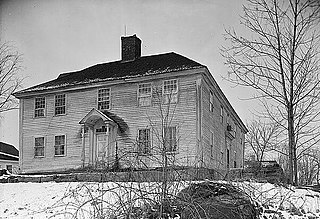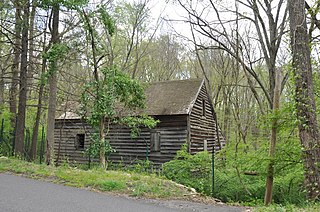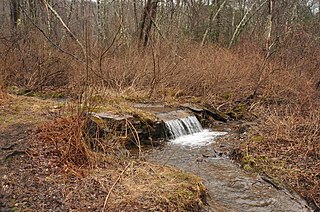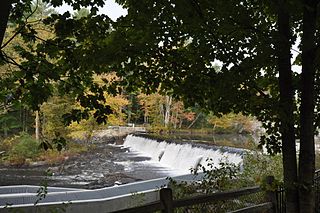
The Stone Arch Bridge is a former railroad bridge crossing the Mississippi River at Saint Anthony Falls in downtown Minneapolis, Minnesota. It is the only arched bridge made of stone on the entire Mississippi River. It is the second oldest bridge on the river next to Eads Bridge. The bridge was built to connect the railway system to the new Union Depot, which at that time was planned to be built between Hennepin Avenue and Nicollet Avenue. The bridge was completed in 1883, costing $650,000 at the time. 117 Portland Avenue is the general address of the historic complex.

The Farmington River is a river, 46.7 miles (75.2 km) in length along its main stem, located in northwest Connecticut with major tributaries extending into southwest Massachusetts. The longest route of the river, from the origin of its West Branch, is 80.4 miles (129.4 km) long, making it the Connecticut River's longest tributary by 2.3 miles (3.7 km) over the major river directly to its north, the Westfield River. The Farmington River's watershed covers 609 square miles (1,580 km2). Historically, the river played an important role in small-scale manufacturing in towns along its course, but it is now mainly used for recreation and drinking water.

The National Register of Historic Places in the United States is a register including buildings, sites, structures, districts, and objects. The Register automatically includes all National Historic Landmarks as well as all historic areas administered by the U.S. National Park Service. Since its introduction in 1966, more than 90,000 separate listings have been added to the register.

This is a list of properties and districts in Massachusetts listed on the National Register of Historic Places. There are over 4,300 listings in the state, representing about 5% of all NRHP listings nationwide and the second-most of any U.S. state, behind only New York. Listings appear in all 14 Massachusetts counties.

The Daniel's Village Archeological Site is an historic industrial archaeological site in Killingly, Connecticut. Located in the vicinity of the crossing of Putnam Road and the Five Mile River, the area is the site of one of the earliest textile mills in Connecticut. The mills burned in 1861 and were not rebuilt, ending the village's economic reason to exist. The site was added to the National Register of Historic Places in 1978. The entire site was purchased in 2015 by a historic building expert who has put the original parcel back together. It is now private property.

The Talcottville Historic District is a historic district in the town of Vernon, Connecticut. Centered on Elm Hill Road and Main Street, it encompasses a 19th-century mill village, including archaeological remnants of very early cotton-spinning facilities, and old stone dam, and a major wood-frame mill constructed by the Talcott brothers. Also included in the village are a significant number of mill worker housing units, many dating to the middle decades of the 19th century, and an 1891 lenticular pony truss bridge, built by the Berlin Iron Bridge Company. The district was listed on the National Register of Historic Places in 1989.

The Packerville Bridge is a historic stone arch bridge carrying Packerville Road over Mill Brook in Plainfield, Connecticut. Built in 1886, it is one of less than twenty surviving 19th-century stone arch bridges in the state, and is a well-preserved example of vernacular 19th century masonry bridge technology. The bridge was added to the National Register of Historic Places in 1992.

The North Stonington Village Historic District is a 105-acre (42 ha) historic district encompassing the historic center of the main village of North Stonington, Connecticut. The district includes a well-preserved small industrial village, which flourished in the years before the American Civil War, and declined afterward. The district was listed on the National Register of Historic Places in 1983.

The Pequonnock River is a 16.7-mile-long (26.9 km) waterway in eastern Fairfield County, Connecticut. Its watershed is located in five communities, with the majority of it located within Monroe, Trumbull, and Bridgeport. The river has a penchant for flooding, particularly in spring since the removal of a retention dam in Trumbull in the 1950s. There seems to be a sharp difference of opinion among historians as to just what the Indian word Pequonnock signifies. Some insist it meant cleared field or open ground; others are sure it meant broken ground; while a third group is certain it meant place of slaughter or place of destruction.

The Jacob Hoornbeck Stone House is located at the junction of Boice Mill and Drum Farm roads in Kerhonkson, New York, United States, a hamlet of the Town of Rochester in Ulster County. It was erected in the early 19th century using the Georgian architectural style, incorporating an earlier house as its rear wing.

The Winthrop Mill is a historic mill building on Mill Street in New London, Connecticut. It is a grist mill located astride Briggs Brook between bridges carrying the eastbound and westbound lanes of Interstate 95. The mill was established in 1650, and the complex retains elements that are believed to be original to its construction. It is now owned by the city and the grounds are open daily; the mill itself is open for tours by special appointment. The property was added to the National Register of Historic Places on November 30, 1982.

The Sylvanus Selleck Gristmill, also known as the Edwin Knapp Gristmill, is a historic gristmill at 124 Old Mill Road in Greenwich, Connecticut. Built about 1796, it is one of the oldest mill buildings in the state, and a rare surviving example of brace-frame construction. It was listed on the National Register of Historic Places in 1990.

Minterburn Mill is a former textile mill complex located at 215 East Main Street, in the Rockville village of Vernon, Connecticut. Developed beginning in 1834, it was the first place in Rockville to be developed industrially, and the surviving buildings provide a view of evolutionary changes in mill architecture. The mill was listed on the National Register of Historic Places in 1984. It was converted into an apartment complex in 2016 by the state.

Sharpe's Trout Hatchery Site is a 1-acre (0.40 ha) site of a former fish hatchery in Vernon, Connecticut. The hatchery was established in 1871 by Christian Sharps, and was abandoned after his death in 1874. The site was listed on the National Register of Historic Places in 1997. Its surviving remnants are located in Vernon's Valley Falls Park, about one mile south of the mill pond.

Humaston Brook State Park is an under-developed day use state park located in the village of Northfield, Connecticut. It preserves a stretch of Humaston Brook, a tributary of the Naugatuck River. Its major feature is Northfield Pond, created by damming in the 19th century. It is commonly known by residents as Knife Shop Pond. It also includes the foundations of the former Northfield Knife Company located along the banks of the brook below the dam, which was the location of one of Litchfield's largest 19th-century employers. Activities in the park include hiking and fishing.

The Wiswall Falls Mill Site is a historic archaeological industrial site in Durham, New Hampshire. It is located in John Hatch Park, a small public park just south of Wiswall Road on the eastern bank of the Lamprey River. The 3-acre (1.2 ha) site encompasses the remains of a small 19th-century mill complex that was one of Durham's major industrial sites of the 19th century until it burned in 1883. The site, which includes remains of the waterworks and foundations, was listed on the National Register of Historic Places in 1988.

The Brattleboro Downtown Historic District encompasses most of the central business district of the town of Brattleboro, Vermont. Extending along Main Street between Whetstone Brook and a junction with Pultney Road and Linden and Walnut Streets, this area includes many of the town's prominent civic and institutional buildings. The area's development took place primarily in the 19th century, with surviving buildings from both the 18th and early 20th centuries. The district was listed on the National Register of Historic Places in 1983, and was enlarged in 2004 to include Plaza Park and the Holstein Building on the south side of Whetstone Brook.

The Phelps Farm Historic District encompasses a collection of farm and residential properties on Connecticut Route 183 and Prock Hill Road in Colebrook, Connecticut. This area is a virtually intact mid-19th century farmstead, with its land under a single family's ownership since the 18th century. The district was listed on the National Register of Historic Places in 1983.

The Broad Brook Company was a manufacturer of textiles in East Windsor, Connecticut, which operated from the 1830s until 1954. The company plant, located on Broad Brook at Main Street and Scott Road in the town's Broad Brook village, was listed on the National Register of Historic Places in 1985. Partially destroyed by fire, with surviving buildings converted into residential condominiums in the 1980s, the complex has been shuttered due to the discovery of toxic soil conditions on the property.

The Plaster House is a historic house at 117 Plaster House Road in Southbury, Connecticut. Probably built in the mid-18th century, it is an extremely rare example of 18th-century stone residential construction in the state. The small structure may have originally been built as a farm outbuilding by a member of locally prominent Hinman family. It was listed on the National Register of Historic Places in 1993.






















